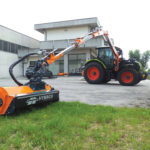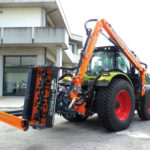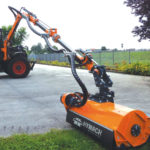The right arm for your tractor
With the arrival on the market of tractors with the new engine with the double tank, false information has been spread about the impossibility of applying the grasscutting arm due to the size of the new chassis of these vehicles. HYMACH, however, accepted the challenge and undertook to find the ideal way to set up this new generation of tractors to continue to offer the tractor-arm combination that it still considers to be more than valid and supported by objective technical and economic reasons. The over thirty years of experience of the company from Stienta in the preparation of the most diverse vehicles for its own professional equipment for green area maintenance have certainly worked in its favour. The user who chooses a tractor equipped with a grasscutting arm has a wide range of possibilities and the freedom to choose the vehicle that gives them most confidence. Once the features that the arm must have are clearly understood, HYMACH custom designs the frame, finding the appropriate solution for each vehicle every time. On this occasion the solution for a CLAAS is presented. The images clearly show the non-invasive frame built to accommodate the anchorage points of the tractor and using the spaces available. Of course, for each tractor, a custom design must be developed but Hymach has always been used to treating each vehicle entrusted to them as unique for the set-up with the aim of creating a stable, efficient and effective machine that can be approved for road traffic. In this case, the EXPANSE-series arm of 10 metres in length consists of two articulated segments and a two-section telescopic section made of ultra-resistant steel that gives it those characteristics of elasticity and resistance necessary to ensure its long life. The structure of the arm is an irregular hexagon designed meticulously to ensure the structural integrity of the various elements. Each side of the hexagon is equipped with runners to regulate the play of the extenders to obtain the least flex-twist and lengthen the life of the same. The runners are constructed in high-mechanical-strength self-lubricating polyamide that prevents steel rubbing on steel and are easily replaceable in routine maintenance operations. HYMACH, thanks to its articulation systems and telescopic terminals, can offer arms up to 15 metres in length that can work from the flush-to the-wheel mechanism up to the maximum extension without encumbering the track, an important fact especially on high-traffic roads.
The non-invasive frame keeps the chassis of the tractor intact and is equipped with an upper stabilisation crossbar with hinges to allow it to be opened in case of need for maintenance to the tractor body. The machine is also equipped with a bracket for supporting the arm when placed in the transfer position that prevents harmful stresses from affecting the entire structure. The ballast, necessary to balance the weight during the extension of the arm, is applied on supports integrated into the load-bearing frame and shaped following the tractor line. The tank/hydraulic control unit is independent of the rest of the structure and is installed at the rear. The functions of the machine are controlled by a digital control panel located in the cabin with intuitive controls and an assisted service program to facilitate routine maintenance, thus maintaining the machine in an excellent state of efficiency. The movements of the arm are controlled by a single-lever joystick that controls the proportional electrohydraulic valve, thanks to which movements are fluid and their speed is determined by the operator. The head, made of aluminium alloy, with a width of 150 cm, is arc-shaped to facilitate the unloading of the cut material. The material with which it is made produces lesser flex-twist, a lower vibration noise level, lower weight for the same size of head and lower wear of the frame as it is equipped with internal protection. The attention paid to the smallest details, the design and development on the vehicle, performed while it is in operation, show that even today, with the appropriate attention to the specific requests of the operators and to the problems they face daily, quality can still be offered at an appropriate price, favouring the human relationship.



